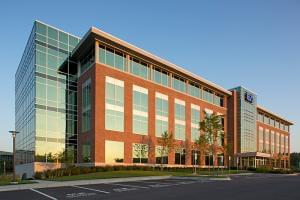The challenges posed by climate change have become an imperative for public and private-sector organizations in today’s rapidly changing world. No longer a distant concern, the impact of climate change is a present reality that requires proactive and strategic management. To navigate these challenges and take advantage of opportunities in the transition to a more sustainable future, it is crucial to have a comprehensive understanding of climate change risks and a well-defined strategy to mitigate and/or address them.
Watch EA’s Environmental Insights webinar focused on managing organizational risks related to climate change. A brief summary is presented below.
While climate is changing, our response as a society is evolving to face the associated risks. Based on data published by the National Oceanic and Atmospheric Administration, there has been a significant increase in the number of billion-dollar natural disasters over the last 40+ years that are related to either weather or climate. This unprecedented increase in natural disasters is driving changes in policy and practice. In addition to recent legislation, such as the Infrastructure Investment and Jobs Act and the Inflation Reduction Act, organizations like the American Society of Civil Engineers are focused on standards and guidelines to reduce risks by increasing climate resilience.
Climate Change Risk
The recently released National Climate Assessment (NCA5) clearly outlines weather risk by region and offers an online data atlas to enable practitioners to explore and identify regional and local risks. Using this information, anyone working within the built environment that does not consider ongoing changes in weather risk could face a future cost well beyond expectations. The NCA5 offers global average temperature forecast scenarios and their expected impacts to weather-related phenomena, which can then be applied over the expected lifespan of a site, region, facility, asset, or proposed project to help reduce climate risks and their associated costs.
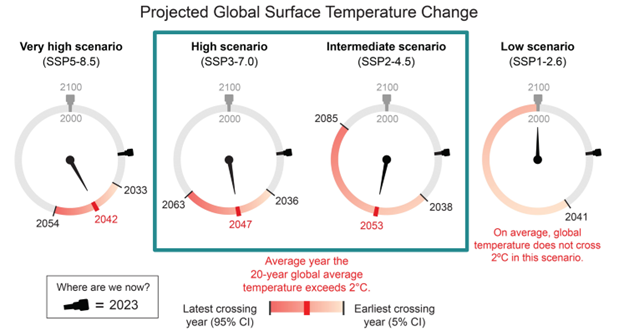
Source: NCA5 Atlas Data | National Climate Assessment Interactive Atlas (https://www.globalchange.gov/)
Vulnerability and Adaptation Strategies
Understanding vulnerability is an important first step to identifying effective adaptation strategies. For any given site, asset, resource, or community, data and tools that evaluate the implementation of effective adaptative and resilience strategies, such as nature-based solutions, are available through federal, state, municipal, and non-profit resources to assist with determining vulnerability.
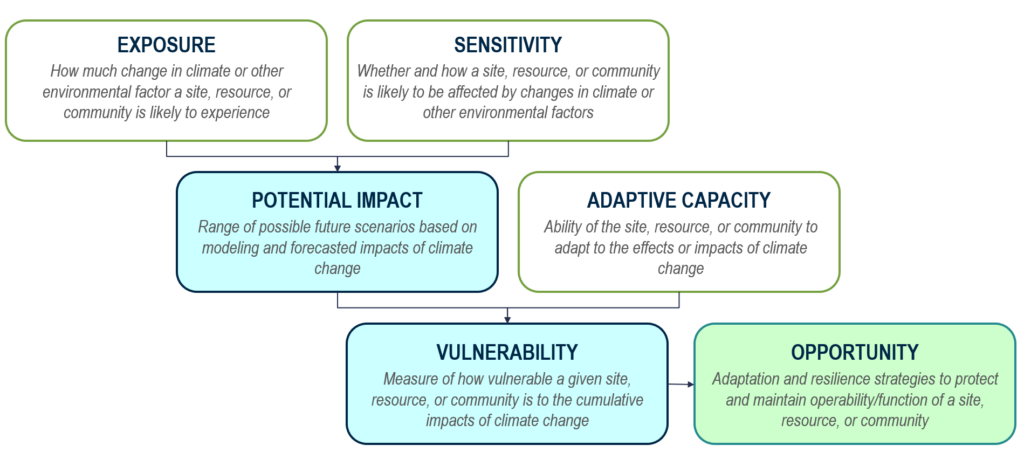
Adapted from: National Marine Sanctuaries (https://sanctuaries.noaa.gov/management/climate/vulnerability.html)
The infographic below outlines examples of climate change risk and strategies:
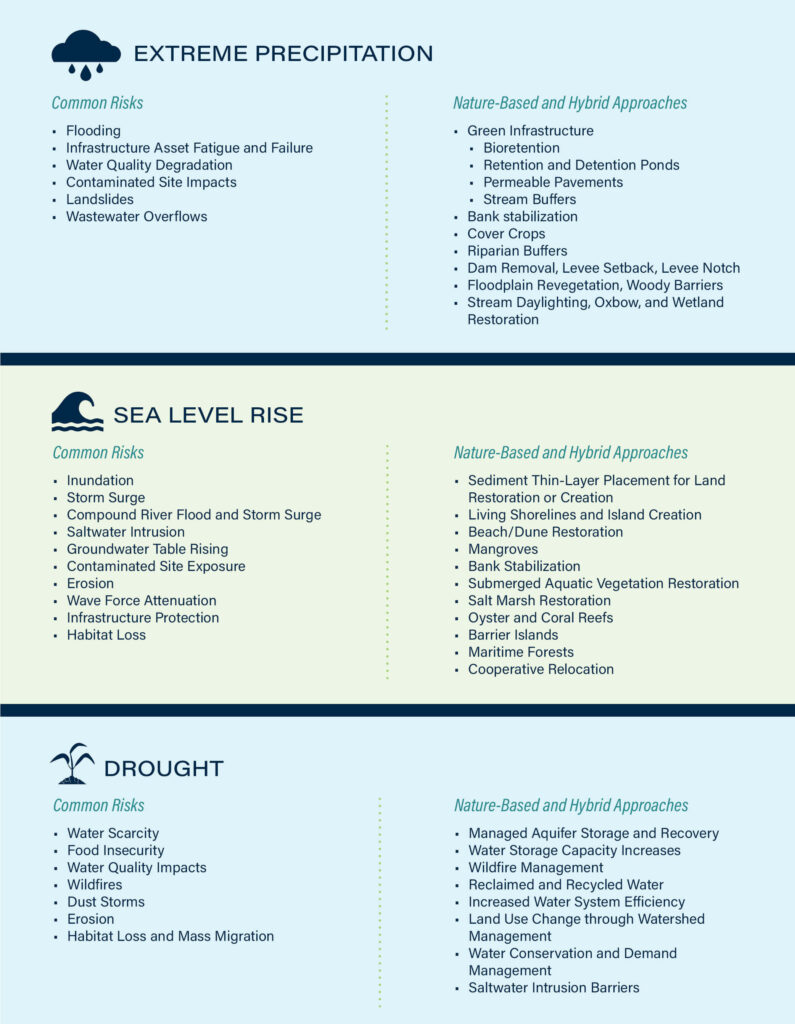
Systematic Approach
Along with the increasing sense of urgency for addressing climate change, there is an enhanced emphasis on acting in parallel to moving from site-specific solutions toward more systematic approaches. As an example, EA has developed a Climate Adaptation Guide through the Department of Defense (DoD) Legacy Resource Management Program. The document focuses on cultural resources across DoD’s geographic footprint and the wide variety of climate change impacts. The work was completed with the idea to integrate adaptation strategies into cultural resource management, and the guide provides an overview of climate change risk to military installations and missions, as well as specifically to cultural resources. The guide presents various climate adaptation strategies for the different types of cultural resources; working with other departments and programs to integrate strategies across multiple program areas is a more systematic, holistic approach. It will also help avoid unintended consequences, such as cutting a fire break through a highly sensitive archaeological area or removing historic materials or fabric from a historic building.
Mitigation
The science-based targets of no more than 1.5°C and 2.0°C global atmospheric temperature increase since pre-industrial times are rapidly moving out of reach due to insufficient mitigation—the reduction/elimination of greenhouse gas (GHG) emissions and increasing the rates of GHG removal from the atmosphere. Peak global carbon emissions continue to be delayed and carbon removal technologies are not implemented fast enough. Mitigation must keep pace to slow and eventually reverse impacts, so the ultimate resource commitment to adaptation does not overwhelm society.
GHG sources that humans are responsible for include carbon dioxide (CO2), methane, nitrous oxide, and black carbon from burning fossil fuels; black carbon from forest fires and open burning; fugitive methane emissions from livestock, oil and gas production, and solid waste and wastewater treatment; and release of high-global warming potential engineered materials like hydrofluorocarbons from refrigerants and solvents.
Short-lived climate pollutants, which include methane, black carbon, and hydrofluorocarbons, are a subset of GHGs that have significantly greater near-term impacts and are estimated to have caused approximately half of the global warming experienced to date. Aggressive mitigation of these pollutants is imperative to have the chance of reaching carbon neutrality by mid-century.
Private and public organizations are being forced to mitigate GHG emissions based on a host of international, federal, and local regulations and agreements or through voluntary measures as part of corporate Environmental, Social, and Governance programs. Complete carbon footprint tabulations that include Scope 1, 2, and 3 emissions are revealing large totals that, in many industries, will make reaching carbon neutrality by mid-century challenging.
There are many anthropogenic pathways for reducing the flow of GHGs into the atmosphere and increasing the rate at which these gases are removed from the atmosphere. Common strategies for reducing GHG emissions include:
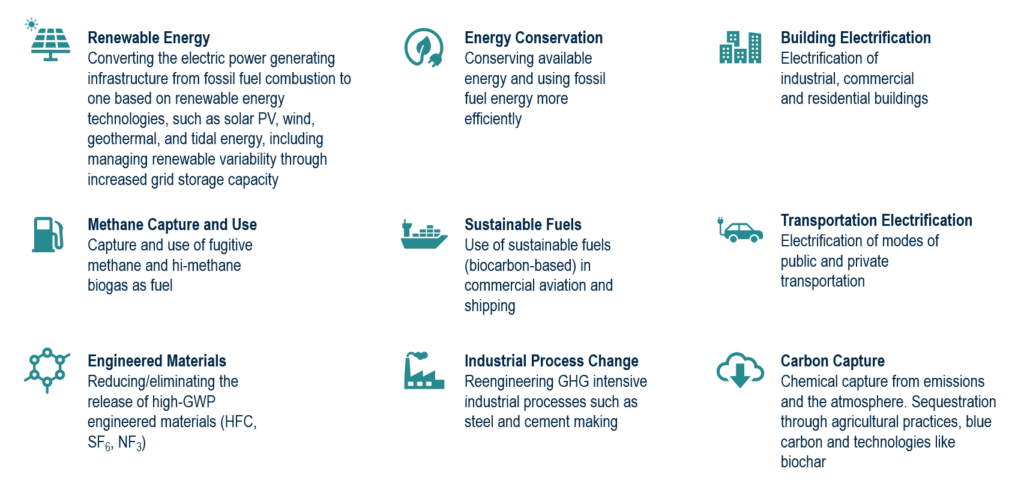
Long seen as a potential means of keeping GHG emissions out of the atmosphere without reengineering our industrial society, carbon capture and storage (CCS) is growing slowly. In 2022, there were 30 commercially operating CCS facilities, 11 facilities in construction, and 153 in various stages of development worldwide, with a combined capture capacity of 244 million tons per annum. To be effective, the number of projects will need to increase by two to three orders of magnitude. Currently, CCS projects face significant technical and economic challenges, including many common process streams not designed for easy CO2 separation, limited commercial outlets for recovered CO2, and transportation costs.
The United Nations Intergovernmental Panel on Climate Change stated that negative emission technologies (NET) will be needed, in addition to GHG emission reductions, to realize carbon neutrality by mid-century. Photosynthetic biomass is the most common NET, currently at a cost of approximately $50 per metric ton of CO2 captured for reforestation. Other nature-based NET approaches include grassland, wetland, and seagrass restoration; cover crops; urban agriculture; and stormwater management.
With the goal of limiting global atmospheric temperature rise to 1.5°C (and now 2.0°C) waning with realization that mitigation is moving too slowly, technologies once considered “edge,” such as direct air capture and solar geoengineering, are receiving more attention.
 For More Information, Contact:
For More Information, Contact:
Chris Anderson, PhD
National Service Line Program Manager for Climate Change
Contact Us
